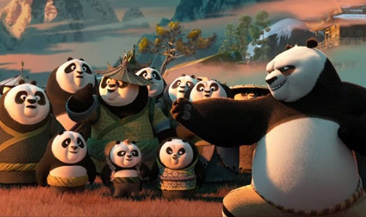The 400-Word Review: Kung Fu Panda 3
By Sean Collier
February 1, 2016
BoxOfficeProphets.com

The voice cast assembled for the series — Jack Black in the lead, flanked by the likes of Dustin Hoffman, Angelina Jolie, Lucy Liu, Jackie Chan, Seth Rogen, James Hong and David Cross — is certainly impressive enough. And for the latest big-screen version, Bryan Cranston and J.K. Simmons have been added to the roster. It’s a vocally dynamic series, anyway, if it’s not particularly inventive in any way.
This time, Po is wrestling with the fact that he’ll eventually have to graduate from student to teacher. No time for much contemplation, though, as there’s a new bear in town: Li Shan, Po’s long-lost biological father (Cranston). Po is brought to the ancestral panda homeland (or something) to bond with his people — err, bears. And there’s an ancient evil spirit invading China, I guess, so Po has to rally the other pandas and his friends and ... You know what, I don’t really remember.
I know that’s poor form for a critic, but that’s just how forgettable Kung Fu Panda 3 is. In the intervening time between the screening I attended and now, I’ve lost nearly every plot detail. It’s almost structured like a low-rate action film, with the exposition occurring only to drive the celluloid from one battle to the next. Admittedly, some of those sequences are okay, but animated action is inherently less compelling than ... well, live-action action. There is a certain degree of artfulness, occasionally aping Asian styles, at work, but it is only sporadically employed.
The main course in any Kung Fu Panda is not the moments of tension — despite how much that card is overplayed here — but rather the physical comedy routines, which do still draw a few laughs; it’s hard to screw up an animated bear falling down a hill. But with vastly superior work produced every year from Disney and Pixar (not to mention stronger in-house franchises such as How to Train Your Dragon), the Panda movies are woefully underwhelming.
My Rating: 4/10
Sean Collier is the Associate Editor of Pittsburgh Magazine and a member of the Broadcast Film Critics Association. Read more from Sean at pittsburghmagazine.com/afterdark